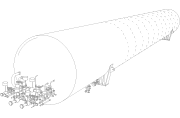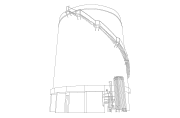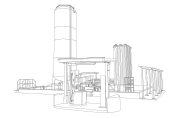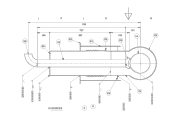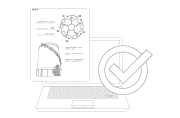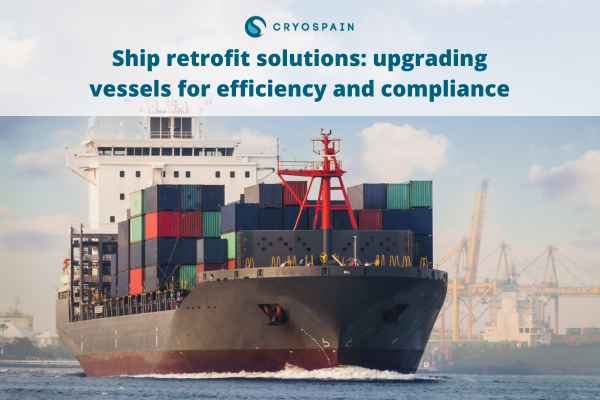The maritime industry is undergoing an unprecedented transformation. With the implementation of new international environmental regulations such as IMO 2020 and the establishment of decarbonization targets for 2030 and 2050, shipowners are compelled to pursue alternatives for modernizing their existing fleets. In this context, retrofit solutions emerge as a strategic approach to enhance operational efficiency, reduce emissions, and ensure regulatory compliance without the necessity of new vessel construction.
The role of ship retrofit in modern maritime operations
What is retrofit and why does it matter in shipping today?
Marine retrofit encompasses the modernization of existing vessels through the installation of advanced technologies, systems, and components. This practice enables vessels to meet increasingly stringent environmental standards while improving energy efficiency.
Don’t miss: Ship Retrofit, two new maritime projects for Cryospain
Significantly, it is estimated that 80% of the global fleet that will be operational in 2030 is currently in service today. This indicates that the sector’s decarbonization objectives are fundamentally dependent on the modernization of existing vessels.
Key drivers for marine retrofit projects
Marine retrofit projects are principally driven by regulatory and economic imperatives:
- IMO Member States have established ambitious targets: reduce the carbon intensity of international maritime transport by a minimum of 40% by 2030 compared to 2008 levels, and achieve a 70% reduction by 2050.
- The EU Emissions Trading System (EU ETS) and Carbon Intensity Indicators (CII) reinforce this regulatory framework, converting emissions into direct operational costs for shipowners.
- Furthermore, from an economic perspective, retrofit offers substantial operational advantages: alternative fuels such as liquefied natural gas (LNG) demonstrate superior cost-efficiency ratios compared to conventional marine fuels, resulting in significant long-term cost savings for shipping companies.
Market analysis indicates that retrofit investments provide attractive financial returns for fleet operators seeking competitive advantages in an increasingly regulated maritime environment.
Main types of ship retrofit solutions
Fuel system conversions for cleaner propulsion
Fuel system conversions represent the most impactful retrofit solutions for reducing maritime emissions. Liquefied natural gas (LNG) stands as the most mature and extensively adopted technology for these conversions.
LNG conversion can be implemented through two primary approaches:
- Complete conversion to single-fuel operation.
- Dual-fuel systems enabling operation with both LNG and conventional marine fuel, providing enhanced operational flexibility.
These conversions require substantial modifications to main propulsion systems, installation of fuel gas supply infrastructure, and cryogenic storage facilities. Benefits include reductions in sulfur oxide (SOx) emissions of up to 100%, nitrogen oxide (NOx) emissions of up to 20%, and carbon dioxide (CO2) emissions ranging from 20-25%.
Emission control upgrades: scrubbers and beyond
Emission control systems constitute another strategic category of retrofit technology. Scrubbers represent the leading solution for sulfur content regulation compliance, effectively eliminating SOx from exhaust emissions.
Available configurations include open-loop, closed-loop, and hybrid systems, each engineered for specific operational routes and regulatory requirements.
Beyond scrubber technology, advanced retrofit solutions incorporate selective catalytic reduction (SCR) systems for NOx emission control and energy optimization devices that enhance operational performance.
Cryogenic retrofit solutions for LNG integration
Cryogenic retrofit for LNG presents unique technical challenges due to extreme operational temperatures (-162°C), requiring specialized engineering solutions while delivering transformative improvements in vessel efficiency.
- Cryogenic storage systems: Type C cylindrical tanks predominate in retrofit applications due to their installation versatility, while membrane tank systems are reserved for high-capacity vessels. Strategic positioning varies according to vessel design: deck-mounted, below-deck, or integrated within cargo areas.
- Fuel gas supply systems (FGSS): These systems integrate vaporization units, pumps, compressors, gas control valves, and specialized controls that deliver fuel to precise pressure and temperature specifications required by propulsion systems.
The interconnection of these components necessitates super-insulated pipes for cryogenics using high vacuum that ensure safe LNG transport without thermal losses, maintaining fuel integrity throughout the distribution network. - Safety and monitoring systems: Safety considerations are paramount. Implementation requires comprehensive gas detection mechanisms, emergency shutdown systems (ESD), specialized ventilation, advanced isolation protocols, and fire suppression systems for secure LNG operations.
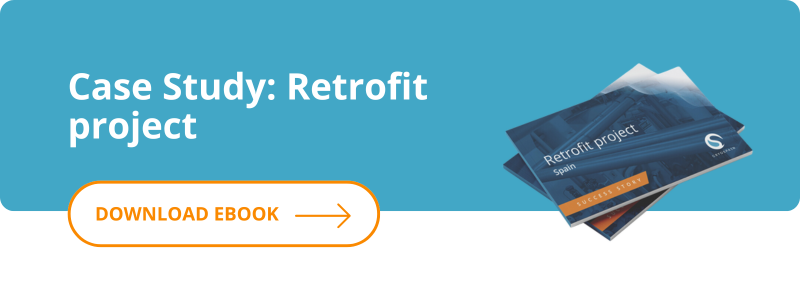
Every retrofit project commences with a comprehensive feasibility study evaluating available space, costs, structural implications, and return on investment. Conversion requires extended dry dock periods for hull reinforcement, piping installation, thermal insulation, and integration with vessel control systems.
Learn more about: Cryospain’s other maritime project in China
Benefits of energy-efficient retrofit technologies
Compliance with international regulations
Energy-efficient retrofit has become the definitive methodology for navigating the current complex regulatory environment. These systems facilitate compliance with EEXI and CII indicators, which have established maritime efficiency standards since January 2023.
The compliance process follows a structured approach: preliminary assessment, technical documentation approval, and compliance certification. Vessels that fail to implement these improvements face operational restrictions and additional costs that compromise their commercial viability.
Environmental impact and decarbonization
Retrofit technologies deliver measurable value through concrete performance improvements. Full-form vessels such as tankers and bulk carriers implementing propulsion enhancement devices achieve power demand reductions exceeding 5%.
You may also like: LNG cruise ships, Cryospain’s mission to promote cleaner shipping continues
Furthermore, the REFRESH project has demonstrated that retrofit can fundamentally transform the energy efficiency of operational vessels. Widespread implementation of marine retrofit will accelerate the transition toward sustainable maritime transport. Det Norske Veritas (DNV) confirms that energy efficiency measures can reduce fuel consumption by 4% to 16% by 2030.
Cryospain: experts in cryogenic retrofit solutions for LNG-powered vessels
Cryospain specializes in the development and implementation of advanced cryogenic solutions for the marine industry, tailored to the specific requirements of each project. With over two decades of experience in cryogenic technology and a proven track record across diverse vessel types, our solutions address the evolving changes of modern maritime operations.
Through comprehensive project engagement, we reaffirm our commitment to cutting-edge cryogenic engineering at the global level.
Our vessel retrofit solutions extend beyond installation: we engineer cryogenic storage systems precisely adapted to each vessel, integrate FGSS systems for optimal performance, and coordinate all components to ensure successful conversion outcomes.
In addition, we design and manufacture custom cryogenic piping, which connects the cryogenic gas refueling point on deck to the ship’s interior systems, delivering the gas to the cryogenic tank, from the tank to the vaporizers, and finally to the engines.
Through close collaboration with shipyards, shipowners, and engineering firms, our approach recognizes that superior results emerge from effective partnerships.
Cryospain’s expertise in cryogenic retrofit technology delivers critical advantages: reduced dry dock time, minimized conversion costs, and optimized operational performance.
For fleet modernization toward a more sustainable and profitable future, Cryospain serves as your strategic technological partner.
Contact our expert team to identify the optimal solution for your project requirements.

